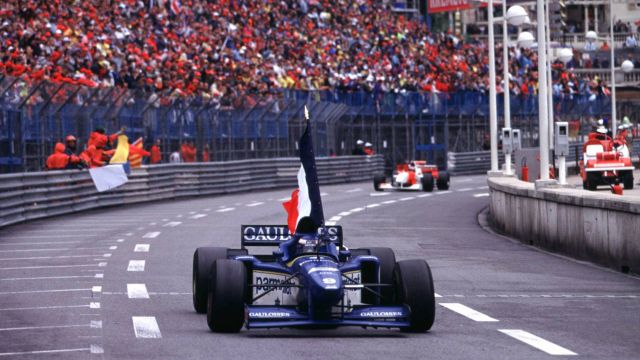What Is The Fewest Cars To Finish An F1 Race?


The fewest number of cars to finish an F1 race was three during the 1996 Monaco Grand Prix. This race was filled with unexpected twists and turns, from multiple collisions to mechanical failures. In the end, only three drivers were able to complete the race, making it one of the most memorable and unusual races in F1 history.
While the 1996 Monaco Grand Prix holds the record for the fewest number of cars to finish an F1 race, there have been several other races throughout history with a similarly low number of finishers. These races often involve challenging weather conditions, tight and winding tracks, and technical issues with the cars. Despite the difficulties, F1 drivers continue to push themselves to the limit and provide fans with unforgettable racing moments.
Notable F1 Races with Few Finishers
Formula One races have seen their fair share of races with few finishers. These races are often characterized by crashes, mechanical failures, and other unforeseen circumstances that prevent drivers from completing the race, which adds to the challenge when you visit betting sites to back a race winner. Here are some of the most notable races with few finishers:
1966 Monaco Grand Prix
The 1966 Monaco Grand Prix is remembered as one of the most difficult races in Formula One history. With only 16 starters, the race saw just four drivers cross the finish line. The race was won by British driver Jackie Stewart, who finished over a minute ahead of second-place finisher Bruce McLaren.
1996 Monaco Grand Prix
The 1996 Monaco Grand Prix saw just three drivers cross the finish line out of 21 starters. The race was plagued by accidents and mechanical failures, with only seven drivers classified. French driver Olivier Panis won the race, his first and only victory in Formula One.
Watch: The Craziest Monaco Grand Prix EVER
Here WTF1 analyse the craziest F1 race ever, the 1996 Monaco Grand Prix.
2005 United States Grand Prix
The 2005 United States Grand Prix was a controversial race that saw just six cars start the race. All of the teams using Michelin tires withdrew from the race due to safety concerns, leaving only the teams using Bridgestone tires to compete. Ferrari driver Michael Schumacher won the race, with his teammate Rubens Barrichello finishing second.
2008 French Grand Prix
The 2008 French Grand Prix saw just seven drivers cross the finish line out of 20 starters. The race was won by Felipe Massa, who finished over a minute ahead of second-place finisher Kimi Räikkönen. The race was marred by several accidents, including one involving Lewis Hamilton, who crashed out of the race on the first lap.
2011 Canadian Grand Prix
The 2011 Canadian Grand Prix saw just 16 drivers cross the finish line out of 24 starters. The race was won by Jenson Button, who started from seventh on the grid and fought his way to the front of the pack. The race was characterized by several accidents and several safety car periods.
2016 Chinese Grand Prix
The 2016 Chinese Grand Prix saw just 11 drivers cross the finish line out of 22 starters. The race was won by Mercedes driver Nico Rosberg, who started from pole position and led every lap of the race. The race was characterized by several accidents, including one involving Ferrari driver Sebastian Vettel, who collided with teammate Kimi Räikkönen on the first lap.
Overall, these races serve as a reminder of the unpredictable nature of Formula One racing. With so many variables at play, it’s impossible to predict how many cars will finish a race, or who will come out on top.
Factors that Affect the Number of Finishers
Formula One races can be unpredictable, and the number of finishers can vary greatly depending on several factors. In this section, we will examine some of the key factors that can influence the number of cars that finish a race.
Weather Conditions
The weather can play a significant role in determining the number of finishers in an F1 race. Wet races, for example, can be particularly challenging for drivers, and can lead to a higher number of retirements due to accidents or mechanical failures. Conversely, dry races tend to be less demanding on the cars and drivers, and can result in a higher number of finishers.
Track Characteristics
The characteristics of the track can also have an impact on the number of finishers in an F1 race. Some tracks are more demanding on the cars than others, with high-speed corners and long straights placing greater stress on the engines and tyres. Additionally, tracks that are narrow or have limited overtaking opportunities can lead to more collisions and retirements.
Driver Skill and Strategy
The skill and strategy of the drivers can also play a significant role in determining the number of finishers in an F1 race. Drivers who are able to defend their position effectively and avoid collisions may be more likely to finish the race, while those who take more risks may be more likely to retire. Additionally, drivers who are able to manage their tyres and fuel consumption effectively may be able to avoid pit stops and finish the race with fewer mechanical issues.
Car Reliability and Mechanical Issues
The reliability of the cars is another key factor that can influence the number of finishers in an F1 race. Cars that are prone to mechanical issues or engine failures may be more likely to retire from the race, while those with more reliable components may be able to finish with fewer issues. Additionally, teams that are able to quickly diagnose and repair mechanical issues during pit stops may be able to keep their cars in the race for longer.
Regulations and Safety Measures
Finally, the regulations and safety measures put in place by the FIA can also have an impact on the number of finishers in an F1 race. Red flags and safety cars, for example, can help to reduce the number of retirements due to accidents by slowing down the pace of the race. Additionally, the use of DRS (drag reduction system) can make overtaking easier and reduce the likelihood of collisions.
In conclusion, the number of finishers in an F1 race can be influenced by a wide range of factors, including weather conditions, track characteristics, driver skill and strategy, car reliability and mechanical issues, and regulations and safety measures. Teams and drivers must carefully consider these factors when preparing for a race, in order to maximize their chances of finishing the race with a good result.
What Is The Fewest Cars To Finish An F1 Race? – Key Takeaways
In conclusion, the fewest cars to finish an F1 race was one, which happened twice in the history of the sport. The first time was in the 1996 Monaco Grand Prix, where only 21 out of 22 cars made it to the starting lineup, and only three cars finished the race due to the wet conditions. The second time was in the 2005 United States Grand Prix, where only six cars started the race due to tire safety concerns, and only three cars finished the race.
The 1996 Monaco Grand Prix was a memorable race due to the challenging conditions, which saw Michael Schumacher crashing out of the race in the first lap. The remaining drivers struggled to keep their cars on the track, and only three cars managed to cross the finish line. The race was eventually stopped after 75 laps, hitting the two-hour time limit, with only three drivers classified as finishers.
The 2005 United States Grand Prix was a controversial race due to the tire safety concerns, which led to only six cars starting the race. The remaining teams withdrew their cars due to safety concerns, and only three drivers managed to complete the race. The race was eventually won by Ferrari’s Michael Schumacher, who started from pole position and led every lap of the race.
Overall, the fewest cars to finish an F1 race is a rare occurrence in the sport, but it highlights the challenges and risks involved in motorsport. While it may not be an ideal situation for fans and teams, it is a reminder of the unpredictability and excitement that makes F1 racing so thrilling.
What Is The Fewest Cars To Finish An F1 Race? – FAQs
What was the fewest number of cars to finish an F1 race?
The fewest number of cars to finish an F1 race is three. This happened during the 1996 Monaco Grand Prix.
What happened during the 1996 Monaco Grand Prix that resulted in only three cars finishing?
The 1996 Monaco Grand Prix was characterized by a combination of tricky weather conditions and numerous crashes. This led to a high attrition rate, leaving only three drivers, Olivier Panis, David Coulthard, and Johnny Herbert, to cross the finish line.
Who won the 1996 Monaco Grand Prix?
The 1996 Monaco Grand Prix was won by Olivier Panis, driving for the Ligier team. This was his only win in Formula One.
Is the 1996 Monaco Grand Prix the only race where only three cars finished?
Yes, the 1996 Monaco Grand Prix is the only Formula 1 race in which only three cars have finished.
Why did so many cars fail to finish the 1996 Monaco Grand Prix?
The reasons varied from car to car. Some had mechanical problems, while others crashed or spun off due to the wet and slippery conditions. The race was especially challenging and drivers needed to showcase their skills to navigate safely and quickly.
What was the reaction to the 1996 Monaco Grand Prix?
The 1996 Monaco Grand Prix is often remembered for its high attrition rate and for being one of the most unusual races in F1 history. Olivier Panis’s surprise victory from 14th on the grid made the race even more memorable. While some expressed concerns about the high rate of retirements, many also recognized the race as a dramatic display of skill and endurance.
What impact did the 1996 Monaco Grand Prix have on the overall championship?
The 1996 Monaco Grand Prix did not have a major impact on the overall championship. Despite winning the race, Olivier Panis did not become a serious contender for the championship title. Damon Hill, who retired from the Monaco race, went on to win the championship that year.





